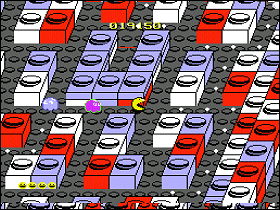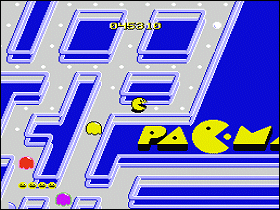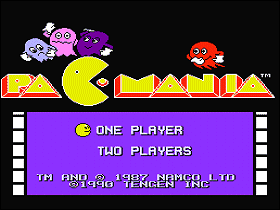 The Game: As a round yellow creature consisting of a mouth and nothing else, you maneuver around relatively simple mazes, gobbling small dots and evading five colorful monsters who can eat you on contact. In four corners of the screen, larger dots enable you to turn the tables and eat the monsters for a brief period. Periodically, assorted items appear near the center of the maze, and you can consume these for additional points as well. The monsters, once eaten, return to their home base in ghost form and return to chase you anew. If you clear the maze of dots, you advance to a new maze and the game starts again, but just a little bit faster… (Tengen, 1990)
The Game: As a round yellow creature consisting of a mouth and nothing else, you maneuver around relatively simple mazes, gobbling small dots and evading five colorful monsters who can eat you on contact. In four corners of the screen, larger dots enable you to turn the tables and eat the monsters for a brief period. Periodically, assorted items appear near the center of the maze, and you can consume these for additional points as well. The monsters, once eaten, return to their home base in ghost form and return to chase you anew. If you clear the maze of dots, you advance to a new maze and the game starts again, but just a little bit faster… (Tengen, 1990)
Memories: Having watched its own home video game unit fall into obsolescence with the rise of the Nintendo Entertainment System, Atari Games – the original Atari’s arcade division, spun off into its own entity after the Tramiel family split the company – quietly started a new subsidiary to begin mining the NES market. This new division, Tengen, produced only a few games – and in so doing, wound up in big trouble with Nintendo.
 In order to avoid the glut of cheap knock-off games that was perceived as the cause of the Atari 2600’s fall, Nintendo instituted a licensing lockdown when it come to producing NES games in North America: all games were manufactured by Nintendo, regardless of who developed them, and a security “gatekeeper” chip was installed in the NES to prevent just anyone from turning out games for the system. Each licensee was only allowed to produce five games a year. Not that it really did stop the tide, though – a few enterprising outfits managed to reverse-engineer Nintendo’s security chip and create their own software that would unlock the machine and allow their games to play. This practice won Tengen a court date with Nintendo, during which the Tengen/Atari programmers insisted that they hadn’t violated Nintendo’s trade secrets. When the case revealed that a copy of the Nintendo security code had been obtained by Tengen through legal channels, however, it was bad news for Tengen. In the end, Tengen only released around 20 games, including Pac-Mania.
In order to avoid the glut of cheap knock-off games that was perceived as the cause of the Atari 2600’s fall, Nintendo instituted a licensing lockdown when it come to producing NES games in North America: all games were manufactured by Nintendo, regardless of who developed them, and a security “gatekeeper” chip was installed in the NES to prevent just anyone from turning out games for the system. Each licensee was only allowed to produce five games a year. Not that it really did stop the tide, though – a few enterprising outfits managed to reverse-engineer Nintendo’s security chip and create their own software that would unlock the machine and allow their games to play. This practice won Tengen a court date with Nintendo, during which the Tengen/Atari programmers insisted that they hadn’t violated Nintendo’s trade secrets. When the case revealed that a copy of the Nintendo security code had been obtained by Tengen through legal channels, however, it was bad news for Tengen. In the end, Tengen only released around 20 games, including Pac-Mania.
Try as it might, this well-done port of Pac-Mania can’t quite bring the arcade game’s graphics to the home audience. The coin-op’s slickly-rendered 3-D backgrounds are  simplified quite a bit here. The good news is that the game play is spot-on, and just as addictive as the arcade game. While Pac-Mania might have lost a bit of graphical finesse during the trip home, the spirit of the game was preserved very well.
simplified quite a bit here. The good news is that the game play is spot-on, and just as addictive as the arcade game. While Pac-Mania might have lost a bit of graphical finesse during the trip home, the spirit of the game was preserved very well.
 Tengen stuck around as a brand name long enough to be seen on games for the Sega Genesis, TurboGrafx 16 and – paradoxically – the Atari Lynx (which was a product of the Tramiels’ chunk of Atari, technically a separate company), but it too folded, with the Atari name and arcade-related intellectual properties eventually being sold off for fire-sale prices in the 1990s.
Tengen stuck around as a brand name long enough to be seen on games for the Sega Genesis, TurboGrafx 16 and – paradoxically – the Atari Lynx (which was a product of the Tramiels’ chunk of Atari, technically a separate company), but it too folded, with the Atari name and arcade-related intellectual properties eventually being sold off for fire-sale prices in the 1990s.
